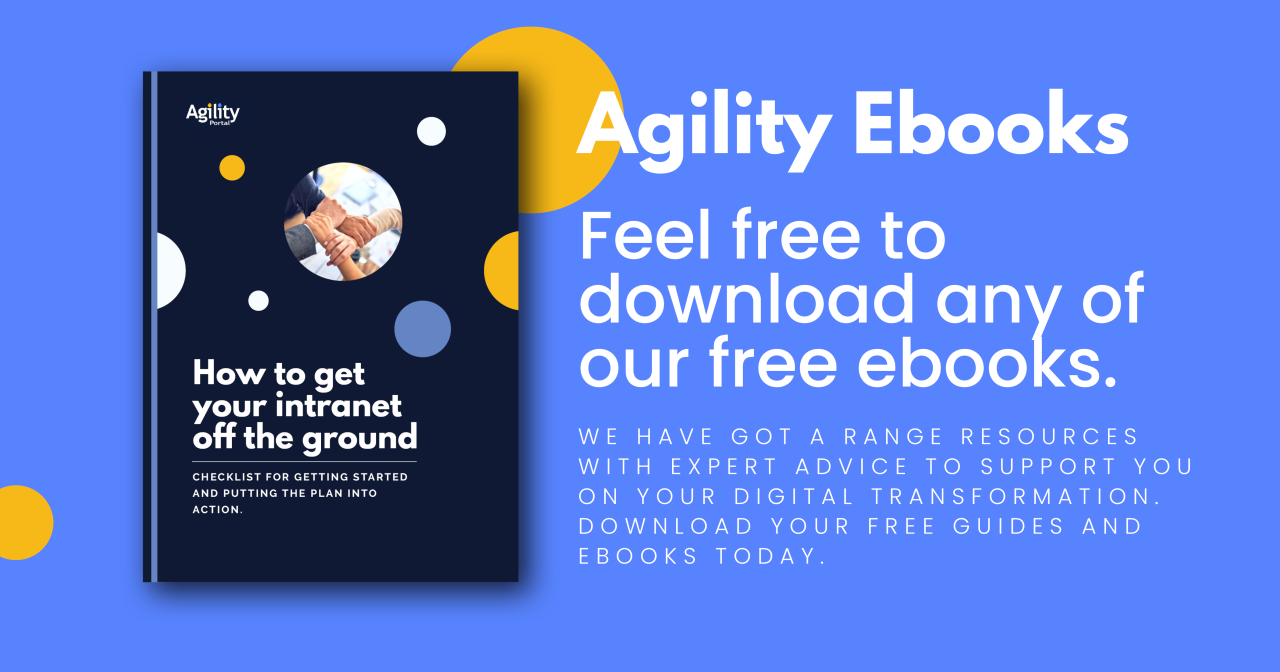Insight Blog
Agility’s perspectives on transforming the employee's experience throughout remote transformation using connected enterprise tools.
9 minutes reading time
(1714 words)
Tips For Creating The Best Employee Portal That Your Employees Will Use
Remote employees are more engaged and happier, involved and more productive thanks to Employee Portal, but the question is are employees using it?
It is of the utmost importance to have an employee portal in place if your organization is in the midst of digital transformation so that you can better handle the associated cultural adjustments.
The successful management of change and the empowerment of workers are two of the most significant problems posed by digital transformation. Well-designed employee portals may provide assistance for both of these objectives.
How have employee portals evolved over time?
People frequently refer to the recent trend of employee portals as the social intranet, also known as intranet 2.0.
Blogs, instant chat, and user comments are just a few examples of the social elements that can be found on the greatest websites of today, which have replaced the static information sites of yesteryear.
This change is sometimes attributed to the new audience that consists of millennials, who are accustomed to having these new means of communication available at all times.
Employee portals have come a long way since their humble beginnings. Early versions were little more than glorified intranets, providing employees with basic information and resources. But today's employee portals are far more robust, offering a wealth of features and functionality.
Today's employee portals are designed to be intuitive and user-friendly, with a focus on delivering a great user experience. They offer a wide range of features, from news and announcements to social networking and collaboration tools. And they're accessible from any device, whether employees are at their desk or on the go.
Employee portals are an essential part of today's workplace, providing employees with the information and resources they need to be productive.
With their ever-evolving functionality
How can you create an effective employee portal?
When creating a new intranet or employee portal, IT teams should consider their employees to be their customers so that they can offer solutions that the target audience of millennials would really utilize. The experience that a customer has here is equally as crucial as it is on the public website that you have.
The development team must maintain an attitude that is receptive to feedback and suggestions for improvement. Improved staff retention, which may be considered the ultimate measure of whether or not your employee portal is successful, will be the payback for this labor, and it will be obvious when it occurs.
What do you need to create the best employee portal?
Define the employee portal's purpose
Companies should know what an employee portal can do. Here is some employee portal aims our clients have:
- Digitize operations like data collecting.
- Invite teams to share files securely.
- Encourage charitable activities and social campaigning.
- Centralizing the communication between employees and the organization.
The portal helps employees grasp company goals and complete duties efficiently. The flexible platform offers many cooperation opportunities. No IT skills are needed to customize your employee portal. Anyone in HR may modify the portal to find documents and create a value-centric workplace.
The site integrates CRM with desk automation. Task automation and approval will ease HR's daily work and improve the organization's overall performance.
Define your organization's needs
An organization is a one-team job; thus, all information should be in one location. An employee portal is a great approach to unifying employees.
Your organization's intranet is the lifeblood of your company, facilitating communication and collaboration between employees. Intranet 2.0 is the next generation of intranet software, designed to meet the evolving needs of your business.
With Intranet 2.0, you can customize the interface and functionality to match the specific requirements.
Whether you need a simple intranet for basic communication or a more complex solution for collaboration and document management, Intranet 2.0 has you covered.
The portal is a social interaction tool; thus, it's crucial to include employees' demands and desired features. You can also prioritize workplace events around holidays like Christmas.
Consider the design of employee portal
We propose these design elements for success:
- Segment your portal by a line of business (LOB) and workgroup.
- Showcase document management, event management, corporate fairs, developing communities, social connections, internal job listings, business rules and procedures, processes, corporate responsibility, and new products.
- Chat rooms.
- Show videos that represent company culture.
Your employee portal should provide company policies, procedures, and expectations. The platform should decrease HR calls and emails. New workers will prefer an online gateway to a printed packet.
Ensure accessibility
The more options an employee has to go to the portal, the better it is for everyone. On-premise or in the cloud, both options have their merits and limitations.
But the optimal scenario is when your employees may access your employee portals via their standard browser, from mobile phones, tablets, and desktop apps.
Continuous monitoring
Many portal software manufacturers are now providing thorough metrics of portal use (i.e., AgilityPortal lets you check key performance indicators).
If you are able to readily observe which tools are being utilized, you may detect bottlenecks as well as individuals who are sluggish to adopt new technologies and may require assistance.
What are the most important features in an employee portal?
#1.Make it fun with gamification
The goal of gamification in an employee portal is to infuse the workplace with a sense of healthy competitiveness and good humor.
It's a terrific approach to keeping workers involved in their tasks. You can easily make the portal more engaging if you include elements like quizzes, surveys, and voting polls like in AgilityPortal.
#2.Mobility
The employee portal must be accessible through tablet or smartphone. It is possible to utilize your employee portal as an app on a mobile device. Your event boards will be visible on your team's cellphones because business is always on the go.
#3.Helpdesk
Employees may have queries or problems with their computers or other technology that need prompt attention. A ticketing system within the employee portal can be implemented by HR and IT departments to provide employees with a place to request technical assistance.
#4.Blog
In terms of information distribution, blogs are a terrific option, but some employees prefer videos. Most employers now prefer to use videos as a means of distributing high-quality material in an engaging manner.
#5.Search
You can have a self-service portal only if your portal is user-friendly; thus, try to focus on quality instead of quantity.
Employees must be encouraged to seek out information on their own.
Your employees must get the information they need with no more than two links.
Possible ways to optimize an employee portal
#1.Add a FAQ section
Questions and answers (Q&A) via an employee portal can help minimize the number of calls and emails that HR receives.
Employees may discover solutions to their questions without having to contact assistance by creating a FAQ section. You may also find out what features or content your employees want to improve your employee portal.
An intranet FAQ section can be a great way to engage employees and provide them with useful information. Here are some examples of how you can use an FAQ section on your intranet:- Employee onboarding: Use the FAQ section to provide new employees with answers to common questions about the company, its policies, and procedures.
- Employee directory: Include an alphabetical list of employee names and contact information in the FAQ section so employees can easily find each other.
- Employee handbook: Post your employee handbook in the FAQ section so employees can reference it anytime, anywhere.
- Company news: Use the FAQ section to share company news, announcements, and updates with employees
#2.Promotion of company's values
Employees will feel more invested in their job if the company's values and purpose are promoted on the site.
Keep the company's ideals in mind while creating a gateway that your workers will be happy to use.
The intranet is a powerful tool for promoting and reinforcing your company's values. By having a dedicated space for sharing company news, information and announcements, you can ensure that employees are always kept up to date with the latest developments. This in turn helps to foster a sense of unity and purpose within the organisation.
As well as being a great way to communicate with employees, the intranet can also be used to promote your company's values to external stakeholders. By sharing updates and news stories about how your organisation is making a positive difference, you can help to raise awareness of your brand and build goodwill amongst your target audience.
#3.Personalization
Keeping employees connected and engaged is the key goal of an employee portal. You can do it by posting employee success stories, along with photos and statements from the employees.
Several elements of the portal, such as the homepage or an employee's newsfeed, might contain employee success stories.
Your intranet is the central hub for your company's communication and collaboration. It's where you share important news and information, and connect with colleagues. Personalizing your intranet makes it more efficient and effective by customizing it to meet your specific needs. Here's how to personalize your intranet:- Choose a custom URL. Your intranet's URL should be easy to remember and brand-friendly. A custom URL also gives you more control over your site's SEO.
- Select a color scheme. Choose colors that represent your brand and reflect your company's culture.
- Add a logo. Your logo will be the first thing visitors see when they arrive at your site
#4.Keep the employee portal organized
Don't overcomplicate things in your employee portal. It's preferable to provide employees with a small amount of information rather than a large amount of information. You can make it simple to find what employees are looking for by sorting the portal by department or content category.
Download our eBook
Categories
Blog
(2616)
Business Management
(323)
Employee Engagement
(212)
Digital Transformation
(174)
Growth
(119)
Intranets
(115)
Remote Work
(61)
Sales
(48)
Collaboration
(36)
Project management
(29)
Culture
(28)
Customer Experience
(26)
Knowledge Management
(21)
Leadership
(20)
Comparisons
(6)
News
(1)
Ready to learn more? 👍
One platform to optimize, manage and track all of your teams. Your new digital workplace is a click away. 🚀
Free for 14 days, no credit card required.










![What Is an Intranet for Business? [2026 Guide] What Is an Intranet for Business? [2026 Guide]](http://agilityportal.io/images/easyblog_articles/1496/b2ap3_thumbnail_What-Is-an-Intranet-for-Business.png)





